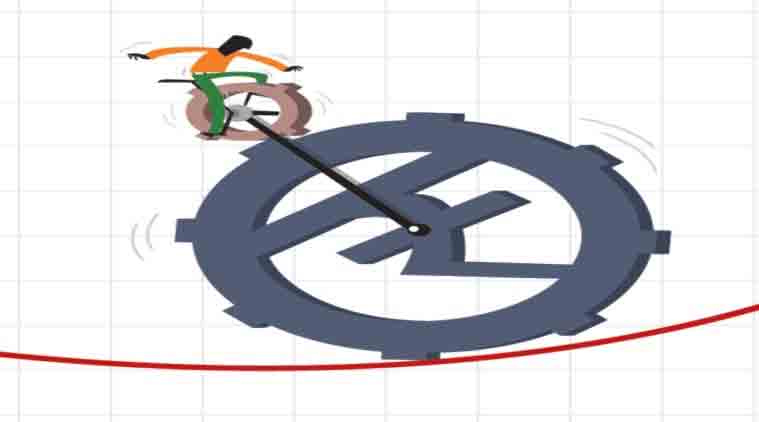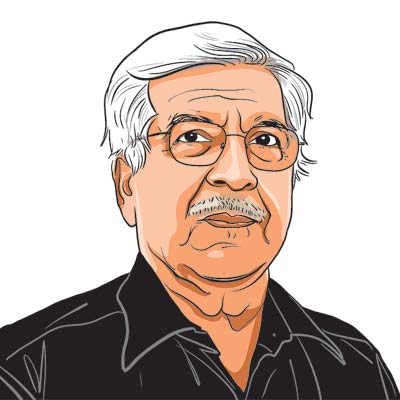Fact Fighting
Statistical estimates on the economy are sacred and need to be treated as such.
Written by Yoginder K. Alagh | Updated: August 28, 2018 9:53:31 am

One would have been happier if the economy had grown faster. It’s to the credit of Rajiv Kumar, Niti Aayog’s vice-chairman, that he has been saying the economy can grow faster and for that investment rates require to revive.
GDP growth rates were never the stuff of Indian politics, until recently. A growth rate of 10 per cent, in particular, is a red rag to the bull. But we have been there before. The last real year of Rajiv Gandhi’s rule, 1988-89, saw GDP in constant prices record a 10.5 per cent growth. I say “real” because it was an election year. It is not a catastrophe that 10 per cent plus growth was achieved by Rajiv Gandhi and a Congress government. The number “10” seems a psychological divide and it is quite likely that 9.8 would have not led to the same flurry.
Now the occupational hazard of an economist like me, with some quantitative pretensions and a past president of the Econometric Society, is that at a young age one had become a member of both the National Income Advisory Committee and the governing body of the National Sample Survey. My senior and friend, V N Dandekar, was chairman and a hard task master. One was trained to believe that facts on weather forecasts and statistical estimates are sacred. As I grew older, I chaired these bodies and the tradition of scrutiny has continued.
But a report of the Committee on Real Sector Statistics submitted to the National Statistical Commission has become a great issue in the fragile political economy of the day. Battles are being fought on expert reports and the devil takes the hindmost. Now it is true that when a professional committee goes deep into some statistics, it is extremely likely that most of what it has to say will survive. Not necessarily all, because the Statistical Commission has a role to play. This is one of the reasons why this writer gets highly disturbed when civil servants are asked to chair search processes for professional positions like heading the Knowledge Commission or the Statistical Commission.
It would be useful to look at the magnitudes the committee has recommended. If the past is any guide, there will be some marginal changes to what they have said and yet the world that they have described will largely remain. The committee would have gone through the process of structural change of the economy in constructing a new world. Its findings imply that the economy grew at an average rate of 7.1 per cent in the period 2013-2014 to 2017-2018. But it grew at 7.7 per cent in the five-year period between 2008-2009 and 2012-2013. Not very dramatic. There is a deceleration of 10 per cent in the growth rate. Given the tentative nature of the estimates, this is significant but not earth-shaking. It makes sense though. Investment rates have been going down also and roughly four rupees of investment lead to a rupee of output, since investment rates are around 30 per cent and output growth is round seven. The slightly greater than two per cent fall in investment rates “explains” the 0.6 per cent fall in output growth.
One would have been happier if the economy had grown faster. It’s to the credit of Rajiv Kumar, Niti Aayog’s vice-chairman, that he has been saying the economy can grow faster and for that investment rates require to revive.
Once upon a time, agencies like the Economic Advisory Council to the Prime Minister and the Planning Commission, the predecessor to Niti Aayog, were known for hectoring the government. The likes of Sukhmoy Chakraborty would lecture the prime minister with the same tone he had for a doctoral class. And they were listened to. The Planning Commission’s mid-term reviews and the reviews of five-year plan documents are still worth reading.
Life has changed now. Advising the government now demands lampooning past governments and defending the government in a manner that would put the government’s Press Information Bureau to shame. To move to an acceptable growth rate, investment rate has to go up substantially, rather than fall. If the professionalisation of the CSO, IMD and National Statistical Commission is maintained, things will improve some day and we will be able to genuinely raise our heads and say satyameva jayate.
The writer, a former Union minister, is an economist
For all the latest Opinion News, download Indian Express App
More From Yoginder K. Alagh
- The Upward PushIncrease in infrastructure spending will place the economy on road to higher growth. ..
- Sowing SlogansMSP is important, but real issues are markets, first-stage processing and supply chains...
- The More Things ChangeEconomic priorities set in Planning Commission in 1970s-80s continue ..







































No hay comentarios:
Publicar un comentario